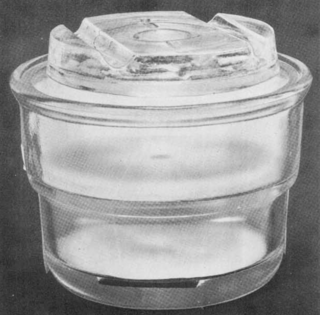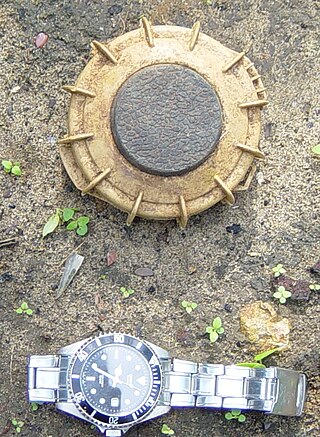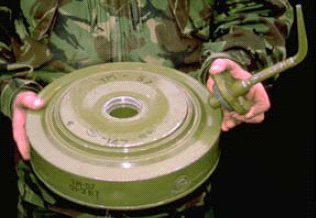Type 72 Non-Metallic is a Chinese circular, plastic bodied landmine which is designed to damage or destroy a vehicle by blast effect.

The Tellermine 35 (T.Mi.35) was a German metal-cased anti-tank mine used extensively during the Second World War. The mine's case is made of sheet steel, and has a slightly convex pressure plate on the top surface with a central fuze well. Two secondary fuze wells are located on the side and bottom of the mine for anti-handling devices.

The Glasmine 43 was an anti-personnel mine with a glass body used by the Nazi Germany during World War II.

The Tellermine 43 was a German circular steel cased anti-tank blast mine used during the Second World War. It was a simplified version of the Tellermine 42, which enabled simpler production techniques. Between March 1943 and the end of World War II, over 3.6 million Tellermine 43s were produced by Germany. Copies of the mine were produced by several countries including Denmark (M/47), France and Yugoslavia (TMM-1).

Anti-personnel mines are a form of mine designed for use against humans, as opposed to anti-tank mines, which are designed for use against vehicles. Anti-personnel mines may be classified into blast mines or fragmentation mines; the latter may or may not be a bounding mine.

The TM-57 mine is a large, circular Soviet metal-cased blast anti-tank mine. It can either be triggered by a pressure or a tilt-rod fuze. A development of the TM-46 mine, it is found in Africa, the Middle East, and South East Asia.

The TM-46 mine is a large, circular, metal-cased Soviet anti-tank mine. It uses either a pressure or tilt-rod fuze, which is screwed into the top. Anti-tank mines with this type of fuze were capable of inflicting much more damage to armored vehicles, when compared to a typical AP mine.

The PMN series of blast anti-personnel mines were designed and manufactured in the Soviet Union. They are one of the most widely used and commonly found devices during demining operations. They are sometimes nicknamed "black widow" because of their dark casings.

The M15 mine is a large circular United States anti-tank blast mine, first deployed during the Korean War. Essentially, it is a larger version of the M6A2 anti-tank mine, which it replaced. Although the M15 has been superseded by the M19 mine, the U.S. retains large stocks of M15s because they are still regarded as reliable and effective weapons. When used against main battle tanks the M15 is primarily a "track-breaker" which creates mobility kills, but has a comparatively small likelihood of causing crew fatalities. However, when used against light vehicles such as APCs or unarmored vehicles such as trucks the damage it can inflict is much more severe.

The VS-50 is a circular plastic-cased anti-personnel blast mine that entered production in 1985. It was formerly made by the now-defunct Valsella Meccanotecnica SpA, an Italian high-tech defence company specialized in area denial systems. The company also the made the Valmara 69, and was one of the first to implement plastic construction for landmines. The VS-50's design is similar to that of the TS-50 and VS-MK2 mines. It is blast resistant and can be used in a minimum metal configuration. Though unlikely to kill, its explosive charge is quite sufficient to destroy the victim's foot, being capable of penetrating 5 mm of mild steel leaving an 80 mm-diameter hole.

The M1, M1A1 and M4 are circular steel cased United States anti-tank blast mines with a distinctive cross shaped pressure spider. The mine was used during the Second World War and a copy produced in Argentina was used during the Falklands War. Another copy is produced in China. designated the No. 4 mine. Variants of the mine have also been deployed in Chad and Tunisia.
The M6, M6A1 and M6A2 are a series of metal-cased, circular, heavy anti-tank landmines produced by the United States from May 1944 to May 1945.

A minimum metal mine is a land mine that is designed to use the smallest amount of metal possible in its construction. Typically, the only metal components are located inside the fuze mechanism which triggers detonation. Both minimum metal anti-tank and anti-personnel mines exist. Some designs contain virtually no metal at all, e.g., less than a gram. This is achieved by encasing the explosive charge in a plastic, wooden, or glass body, with metallic components limited to the few small parts in the fuze which can not easily be made from other materials, such as the spring, striker tip, and shear pin. Minimum metal mines are extremely difficult to detect using conventional metal mine detectors and usually require modern techniques, such as robotic Multi Period Sensing (MPS) equipment, to identify, but it is still extremely difficult to find non-metallic mines. These techniques are usually restricted to well-funded international mine clearing organizations and major militaries, making minimum metal mines especially pernicious where they are encountered.
The PT Mi-Ba is a circular Bakelite cased Czechoslovakian minimum metal anti-tank blast mine. The mine entered service with the Czech and Slovakian armies in the 1950s and is now obsolete and no longer in service. The mine is conventional in layout with a central pressure plate, and doughnut-shaped main charge around a booster charge and RO-7-II fuze. The mine's fuze is the only component that contains any metal, and this is limited to a spring, the striker pin, and the detonator capsule.
The TM-41 was a circular, metal-cased Soviet anti-tank landmine used during the Second World War. The mines case consisted of a short cylinder with the entire top surface being used as a pressure plate. The mine has a carrying handle on the side of the mine. It was normally painted olive drab and was broadly similar to the larger, later, TM-44 mine.
The TM-44 was a circular metal-cased Soviet anti-tank landmine used during the Second World War. The mine's case consisted of a short cylinder with the entire top surface being used as a pressure plate. The mine was normally painted olive drab and was broadly similar to the earlier, smaller, TM-41 mine.

The Pappmine or Cardboard Mine in English was an anti-tank mine that was developed by Germany and used by the Wehrmacht during World War II.
The Bakelite anti-tank mine type I and type II were Italian anti-tank mines produced during the Second World War. As the name suggests, the mines used Bakelite cases and used relatively few metal components, making them difficult to detect with mine detectors of the era. It was primarily used to deter pursuit when withdrawing from an area.

The Pignone mod.43 were bakelite cased Italian anti-tank blast mines used during the Second World War in North Africa and Italy.
The A.P. Mine No. 5 was a British Anti-Personnel mine of World War II.












